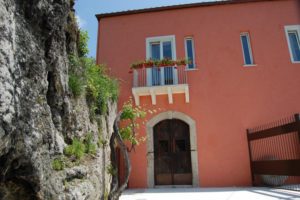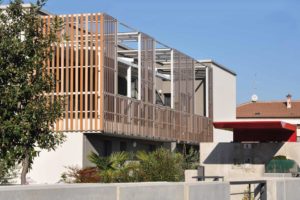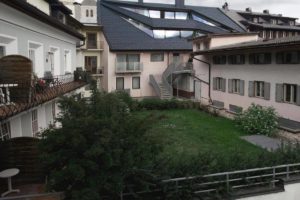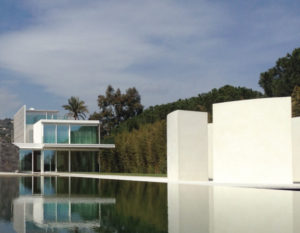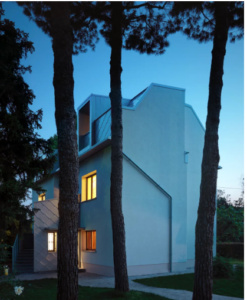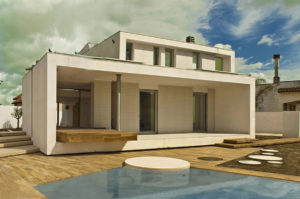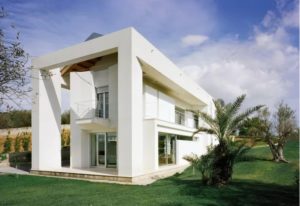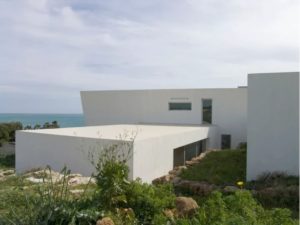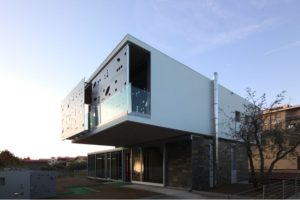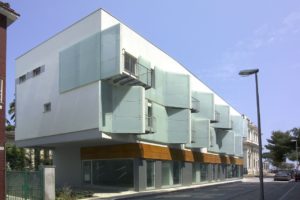Antico mulino ad acqua che partecipava ad un insieme di strutture settecentesche nate come opifici e nel tempo trasformate in case agricole per la famiglia dei Marchesi Moscati di Faiano. Questo è il recupero del terzo lotto al quale si è deciso di dare una funzione commerciale turistica. A monte e a valle insistono la villa originaria recuperata negli anni novanta e un’altra dipendenza recuperata nel 2005. I merli furono costruiti alla fine dell’ottocento sula falsariga delle case coloniche fortificate a scopo difensivo nell’ottocento nell’area napoletana.
Edificio residenziale per 8 appartamenti di media/grande metratura. La forma e l’orientamento del lotto hanno suggerito un intervento edilizio che prestasse attenzione sia alla qualità degli spazi abitativi che al rapporto con il verde, presente in percentuale molto alta all’interno della proprietà. Innovazione, risparmio energetico e sostenibilità sono le linee guida di questo progetto.
Tipo di intervento: Nuova costruzione
Data di progettazione: 2009
Data di realizzazione: 2011
Luogo: Vigasio, Verona
Committente: Abitare Srl
Impresa: Abitare Srl
Progettisti: arch. Saverio Antonini, arch. Licia Lavagnoli, OWC Arkitekt
Strutture: Cemento armato e laterizio
Superficie Lotto: 2.350 mq
Superficie utile lorda: 1.416 mq
Efficienza energetica: B
EDIFICIO CERTIFICATO CASACLIMA
Villa A is the result of a double intervention: the re-use and restructuring of an existing house and a new extension close to it. The project insists on the dialogue between these two realms as a metaphor of both a traditional and domestic intimacy and a contemporary and clear extroversion.
In fact, if the existing building conserves its closed and massive character, the new one is transparent and luminous. If the former keeps its original pitched-roof geometry and materials (mostly lava stone and wood) the other plays with a minimal geometry and more contemporary materials (steel and glass).
Moreover, in the old structure the roof of many rooms has collapsed and we decided not to restore them to use them as internal patios to provide light and air to the entire complex.
This part is composed by a single level while the new one is composed by three stories above ground and one below. At ground level in the old part there are a double-high kitchen with wooden beams , utility areas, and an independent dependence. In the extension the ground level is entirely occupied by a double level salon/dining completely transparent in all the directions to benefit the views of the garden and the patios all around.
At the first floor of the new part there are three bedrooms each with its own bathroom and at the second floor there is another room with its own bathroom enjoying a solarium and a pensile garden with beautiful views of the sea. The below-ground floor hosts a multifunctional salon and utility areas.
The project is most of all characterized by an intentional environmental care. In the south of Italy the major problem is to protect a building from heath rather from the cold of its tempered winters. So the old complex benefits from the inertia of its thick walls while the façades of the villa employ glasses with adequate solar and exterior curtains. On the roof the pensile garden plays its fundamental cooling role. Finally in the western side of the villa a shading/cooling wall has been conceived to protect the house. More generally sea breezes coming from south slide over the pool creating a cooler microclimate in the site while natural ventilation has been enhanced in the house. The result is an extremely low consumption of energy for air conditioning..
Particular attention has been given to the design of the exterior spaces. The narrow geometry of the site, sloping down towards the sea has been emphasized by the long water mirror that becomes a swimming pool. The dimensions are 58 m in length and 7 m in width. The last 20 m are occupied by the swimming pool while at the center there is a 3 x 3m hydro-massage area. The water mirror has a 10 cm depth and it degrades with a staircase to -1.2 m in the central part of the swimming pool to the -2.50 of the diving pool. The whole starts from the stone wall of the kitchen’s patio and spans to the end of the garden to merge with the sea in front of it. The wall of the patio is cut with a single vertical slot to enhance the landscape from the kitchen and the patio, and from this slot a narrow passage leads to a solarium surrounded by water. Finally, the pool inherits the grey color of the sea beds of the region becoming part of the landscape For this reason it has been awarded the Italian Pool Award 2014.
The interior design of the Villa_A follows the same strategy of the overall project: the interiors are strongly interconnected with the exteriors space and the choice of materials play with the two realms. In the living dining room two materials differentiate the two levels of the ambiance: white natural stone for the area of sofas and a woodwork for the library/staircase area that will accommodate the dining area with a more intimate atmosphere. In the kitchen white is the predominant color to emphasize diffuse light. The dining area is aligned with passage leading to the pool outside the patio in front of the kitchen. The furniture has been chosen for its minimalist simplicity. Below ground there’s a multimedia hall. The back lit ceiling uses the same material of the projection screens. Trapezoidal glass blocks bring light from the external interstice protecting the house from the surrounding terrain. Finally each of the bathroom has been characterized with different materials.
Il progetto intende recuperare il sottotetto attraverso un’operazione di ridefinizione volumetrica dell’edificio. L’intenzione progettuale è quella di escludere un intervento che si configuri come volume sovrapposto ad esistente; il nuovo sottotetto deve riconfigurare l’edificio nella sua totalità, in modo tale da definire un nuovo organismo architettonico. Per questo motivo, l’intervento prende le basi dalla copertura esistente che ha nella sua doppia articolazione un elemento di qualità. Attraverso operazioni di compressione ed estensione del volume, abbinati ad elementi di completamento, si configura la nuova copertura. Essa si adatta alla pianta esistente e definisce un volume che si innesta in modo affine sull’impianto esistente. La volontà di restituire all’edificio un senso di unitarietà è giocato attraverso la definizione delle aperture e la configurazione del manto di copertura. Le aperture hanno una doppia natura: quelle principali sono posizionate in prossimità dei terrazzi scavati all’interno della sagoma, questo permette di mitigarne la presenza nella visione dall’esterno; le altre si posizionano in una composizione armonica con quelle esistenti. L’elemento posto in colmo ha una doppia funzione: estetica nella definizione volumetrica della nuova copertura e funzionale nel permettere l’illuminazione zenitale e il ricircolo naturale dell’aria. Il volume è stato verificato attraverso una serie di modelli a varia scala.
In tutti i casi è evidente come l’articolazione della nuova copertura permetta di definire unitario il volume dell’intera costruzione. Il manto di copertura non si limita ai piani inclinati ma, in base ai prospetti, scende verticalmente a ridisegnare la composizione della facciata. Il manto è in scaglie di metallo preverniciato color grigio chiaro tipo Rheinzink. Questa tipologia (a scaglie) permette di dare all’intera copertura un’aria domestica, al contrario di coperture a lastre graffate. Inoltre, è facilmente gestibile il passaggio da verticale ad orizzontale. L’immagine finale dell’edificio appare unitaria e consolidata, essa completa in maniera simbiotica la vasta area verde a giardino e ragiona sul confronto dei toni e dei colori, naturali e artificiali (verde/bianco).
DESIGNER – ES ARCH ENRICOSCARAMELLINIARCHITETTO
DESIGN – ARCH. FRANCESCO MANZONI
PHOTOS BY – MARCELLO MARIANA
Intervento di ampliamento e ristrutturazione di una villa in un contesto particolarmente degradato del litorale Laziale. Il progetto si basa sulla logica del recinto, generando un sistema introverso che esclude il contesto, valorizzando il rapporto tra l’edificio e lo spazio esterno. Il giardino, la piscina e la residenza sono pensati come un unicum in cui risultano labili i confini tra esterno ed interno. Volumi puri, bianchi, definiscono il costruito, prendendo origine dalle forme della preesistenza, si aprono verso sud, favorendo l’ingresso della luce e la vista del giardino, come due grandi cerchiature “sospese”. Il patio si articola con variazioni altimetriche attraverso l’inserimento di una pedana aggettante, secondo la teoria del Raumplan oltre a costituire una maschera d’ombra per il raffrescamento della zona giorno. Il vano scala, strutturalmente indipendente dal corpo di fabbrica, è costituito da un setto pieno, vetrato in copertura, i gradini sono a sbalzo costituiti da lame in ferro di soli 2,5 cm di spessore, lasciando vedere le piante sottostanti. L’ingresso è caratterizzato dalla scomposizione del sistema del recinto, attraverso setti filtro disposti come un codice a barre.
Il sito inteso come luogo edificatorio ha svolto nei confronti dell’impianto di casa Granata un ruolo fondamentale.
Una “sottile” striscia di territorio che si svolge dolcemente lungo il pendio, osserva discretamente la splendida vallata del versante calatino di Grammichele.l’edificio, progettato nel 1998, ultimato nel 2006, è frutto della collaborazione fra Giuseppe Merendino (Pekstudio) e Rosario Sgroi (Studio Archè). Gli architetti hanno ideato un impianto longitudinale che di fatto, sembra incastrare la casa nel terreno privilegiando gli affacci sulla valle. In un curioso gioco distributivo le funzioni di zona giorno e zona notte si incastrano ad x svolgendosi entranbe sui due livelli di vita dell’edificio. La scelta di rapportare l’ architettura al paesaggio e far appartenere il paesaggio all’architettura è stata alla base della volontà di selezionare opportune bucature nel volume dell’edificio, tali da introiettare la natura circostante.
Casa Spinale, ad Augusta, è fortemente caratterizzata dalla configurazione del lotto in cui sorge. Una stretta lingua di territorio larga 50 mt e lunga un chilometro, scende lungo un pendio affiancato dal letto di un torrente fino al mare. Le direttrici fondamentali del progetto inquadrano longitudinalmente il mare e trasversalmente il vulcano Etna e diventano l’occasione irrinunciabile di orientamento del cannocchiale del livello superiore che ospita le attività della zona a giorno, e dello svuotamento del fronte mare del piano interrato che ospita le funzioni della zona notte.
Casa C+V
Casa Capece_Venanzi è una casa suburbana; una casa nata nella conurbazione diffusa della costa
adriatica in una delle possibili aree di una città qualsiasi nel segmento tra Ascoli e Pescara. Un’area “intermedia”, (apparentemente) “senza qualità”, un lacerto di terra rimasto senza costruzioni, all’ attacco tra la pianura e la collina, in un brano di città in cui il tessuto urbano presenta le prime “smagliature”. L’idea progettuale è quella di costruire un edificio con un orientamento completamente rivolto verso la collina, collina che viene vista come una sorta di “mare” verde su cui affacciarsi. L’impianto è definito da uno sviluppo in sezione su tre livelli:
– Livello interrato completamente scavato nel terreno:
Un patio interno è l’elemento intorno al quale si organizzano gli spazi, costruendo un gioco di
traguardi tra gli spazi interrati/il tetto giardino/l’area giorno(pt), il volume sospeso del piano secondo.
– Primo livello/piano terra: è la parte collettiva dell’edificio, dove una grossa vetrata scorrevole segna il
confine tra il tetto giardino scoperto e l’area giorno coperta. Lo spazio ruota intorno ad una scala metallica lamellare che si connette con il piano primo.
– Il piano primo: accoglie le camere e gli spazi privati dell’edificio (bagno/sauna, palestra, studio). L’argomento compositivo principale è giocato sulla metafora della trasposizione macroscalare di un
pezzo del gioco del tetris. I due volumi contrapposti mettono in scena le due parti dell’edificio e ne denunciano la diversità di uso, con un duplice trattamento materico: un basamento rivestito in pietra con un volume di intonaco bianco. Il basamento in pietra è “tagliato” sul fronte ovest da una vetrata a tutta altezza, mentre il volume stereometrico sovrapposto al piano terra presenta una trama di bucature di forma libera e circolare. La serie di bucature libere sono, inoltre, la trama del disegno dei pannelli in alluminio che schermano le grosse bucature sud-ovest e che “slittano”al piano terra disegnando recinzione, cancello e sistemi di chiusura. La luce è uno dei materiali del progetto. Il sistema
di bucature ritagliate nella muratura e nel solaio di copertura disegna, durante il giorno, le ombre e le luci portate all’interno del volume del secondo piano; al piano terra la luce inonda tutti gli spazi. Di notte un sistema di illuminazione a led (gestito da un controller) definisce una serie di “sfondi”
che trasformano il fronte vetrato del piano primo in una parete luminosa. Nel gioco dei contrari, sulla parete vetrata (luminosa) si appoggia a sbalzo il volume del piano primo.
Ex arena braga
Il sito è parte del tessuto urbano d’espansione di una città della lunga conurbazione diffusa della costa adriatica; esso è posto alle spalle di uno dei più vecchi e gloriosi edifici ludici: il Kursaal. L’edificio è disposto su un lotto rettangolare allungato con orientamento est-ovest, a ridosso del lungomare; i temi del progetto si misurano con la risoluzione tipologica e morfologica di una serie di istanze che ad una prima lettura sono fortemente penalizzanti:
– la geometria notevolmente allungata;
– la destinazione d’uso del piano terra (attrezzature e servizi_cinema) che richiede un attacco a terra completamente libero;
– la presenza, sul lato sud, di un edificio molto alto e ravvicinato.
Il progetto reinterpreta tutto ciò tentando di renderli elementi di connotazione architettonica:
– la distribuzione verticale, al fine di rendere fruibile il piano terra senza soluzione di continuità, è stata posta in testata diventando essa stessa prospetto (principale) emettendo in scena il sistema dei flussi dell’edificio;
– il tema dell’introspezione e della regolazione/captazione della luce, indotto dalle forti presenze di confine, è diventato l’argomento generatore di una pelle in vetro che avvolge l’edificio, diventa l’interfaccia tra interno esterno, regolatore della luce ed elemento unificante che camaleonticamente muta geometria e forma “registrando” gli usi molteplici che avvolge. Una pelle che si sfoglia e piega costituendo uno schermo di protezione visiva ed allo stesso tempo una macchina per la captazione della luce. La pelle è si luogo dei riflessi, dei riverberi visivi; le finestre scompaiono, le “squame” disegnano tagli e sporti, una sorta di superficie “a spessore”. Nello spessore sono raccolti degli affacci a sbalzo in acciaio traforato che traguardano, come dei punti di avvistamento, il mare.L’edificio accoglie delle residenze temporanee per vacanze. L’idea, anche in ragione della morfologia fortemente allungata
dell’edificio, è quella di pensare questi spazi quasi come spazi nautici più che come residenze piantate sulla terraferma; l’accesso a tutti gli alloggi avviene da un lungo “ponte” posto all’ ultimo piano, da cui si distribuiscono gli ambienti giorno degli alloggi. Dall’open space soggiorno/cucina con delle scale (in ferro e legno) interne si possono raggiungere le cuccette/camere al piano inferiore (in coperta) o risalire sul ponte/terrazzo posto al piano superiore. Il sistema degli alloggi “galleggia”su di un piano terra completamente svuotato e smaterializzato nel suo attacco a terra da una lunga vetrata. Il confronto,all’interno di un tessuto edilizio amorfo, con l’unica emergenza rappresentata dall’edificio novecentesco del Kursaal è cercato nel continuo contrapporre forme e materiali che tentano di interpretare la leggerezza (vetro, metallo, laminato) alla matericità delle masse murarie intonacate del kursaal. Negli occhi di chi scrive si riflettono le immagini della lama di mosaico bianco che si affaccia tra gli edifici neoclassici di corso Italia a Milano o la casa della cooperativa Astrea e “il girasole” di viale Buozzi a Roma. Le istanze funzionali sono il pretesto per misurarsi con il patrimonio di progetti e realizzazioni consegnatoci dagli architetti italiani degli anni 50/60. Un brano di storia di estremo interesse, poiché ci si è misurati con l’ibrido, il molteplice, l’incerto. Una condizione spuria che, credo, appartenga al nostro lavoro.
Un omaggio a Luigi Moretti.
